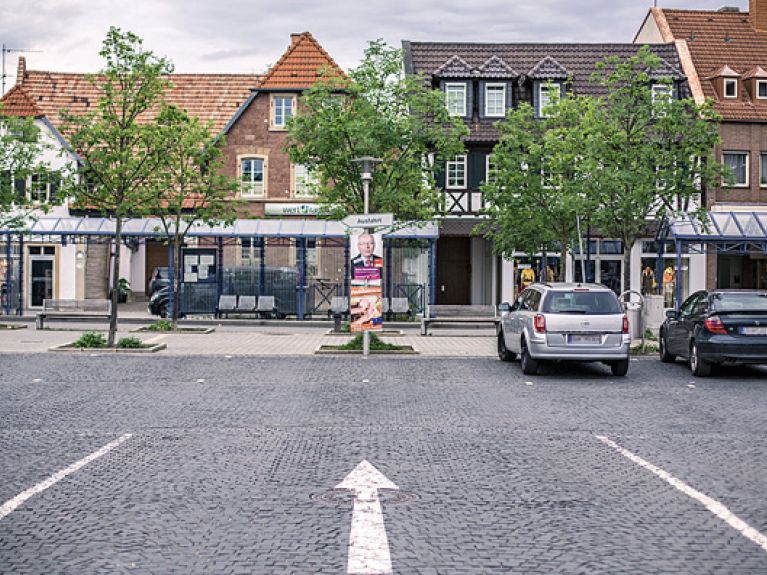Where the average German lives
A small town in the Palatinate is considered the most average municipality in Germany and therefore functions as a test area for market researchers.

It’s nine in the morning and the bakery is getting busy. Some customers hurry in to buy rolls and pretzels, others are calmly enjoying a cup of coffee at the bar tables. The atmosphere is pleasantly lively. Were you to close your eyes and not listen too closely, you might think your were in an espresso bar in northern Italy. However, the broad Palatinate dialect is unmistakeable. Six middle-aged ladies are taking about local matters and their personal mental state, about people, not present, who are moving house, and about a recent death. “Oh God, no, …”
By contrast, a couple of hundred metres further up the street the world seems to be holding its breath. Not a person in sight, and an unusual silence. Occasionally a car can be heard, and now and then a bicycle flits quietly past. The scene is dominated by well-tended house facades in pastel shades. A few sparrows are twittering on the rooftops and a cock is crowing in the distance. Then there are those moving curtains, with someone behind them. Welcome to Hassloch, in the heart of the Palatinate.
Approximately 21,000 people live in this municipality, and the number is growing. “It’s very attractive for families with children to come here,” says Michael Rossdeutscher. The newly-built district on the southern periphery of the town has been very well accepted. It has practically everything you need, he believes. Rossdeutscher is director of the local planning department and has lived in Hassloch since 1982. “We have 103 associations, all school types, a swimming pool, and we are located close to the highway.” The rail connections are also good. Many of the working population commute to, among other places, Ludwigshafen, about 25 kilometres away, to BASF, the world’s largest chemicals company. A new industrial campus is also being built in Hassloch. This is a dynamic place.
And yet these are not the features that have repeatedly put Hassloch in the news. The municipality gained national renown as a test area for a consumer research company called Gesellschaft für Konsumforschung (GfK). The market suitability of new products is determined here – by real consumers in real shops. The ongoing tests involve roughly 3,500 of the total of 11,000 households in Hassloch, Göran Seil, head of the test markets section at GfK explains. “These make up a miniaturised image of all households in Germany.” The age structure of the test group resembles that of the whole Federal Republic, says Seil. For example, the percentage of households with a “housekeeping person” less than 30 years of age is 10%, which corresponds precisely to the German average. “The income distribution is also equivalent.” The purchasing power index in Hassloch is 101 points, compared to 100 points in Germany as a whole. It’s a statistician’s dream with ideal conditions for market researchers.
It all started in 1985, when cable TV conquered Germany and this “large village” in the Palatinate was one of the first municipalities to be linked to the network. This was decisive for the experts at GfK. Thanks to cable TV, it was now possible to deliberately target advertisements. Only the people in Hassloch saw them, not the rest of Germany. This approach is still being used today. Viewers do not know which of the countless messages appearing on screen is part of the test programme. Nor is anything particularly obvious in the local supermarkets. “We market about 15 new products per year in retail stores here,” Göran Seil reports. In Germany overall, the number is 30,000. You have to look very carefully if you want to discover the test products mixed in among the other goods on sale in Hassloch.
A test run for a new product under realistic conditions may be rather costly for manufacturers, but in the end it can save them much more money. After all, national flops are far more expensive. A toothpaste with a flavour consumers do not like or a sweet that is considered uncool can often become a greater burden on a company’s balance sheet than a locally restricted market test. And that is the advantage of this test laboratory in the Palatinate, Göran Seil emphasises. “What doesn’t appeal to people in Hassloch will not appeal to people throughout Germany.” And, according to the expert, this has been confirmed by 29 years of success. “So far we have not had a single incorrect prognosis.” GfK clients can also test how effective different advertising strategies are in Hassloch. What is the most effective combination of advertisements in print media and TV commercials? What are the advantages of tastings in shops? Even the return-on-investment of an advertising campaign can be calculated in advance, says Seil.
The test participants are offered certain inducements. The sales assistant at the butcher’s, Manuela Ruffer, and her family have been part of a test group for 20 years. “We are sent a TV guide every week,” says the good-humoured woman with a smile. There are also regular contests, vouchers and the like. Unfortunately, the discounted monthly cable TV fee has been discontinued. The purchasing behaviour of the Ruffers, like that of all the other people in the sample group, is precisely recorded by the help of a chip card. This has to be presented every time they buy something in one of the supermarkets involved: transparent consumers in the service of the retail industry.
But is Hassloch really as average as the statisticians would like to think? Is there such a thing as a “Hassloch attitude towards life”? Jasmin Özdüzenciler, born in Landau in the Palatinate, moved to Hassloch four years ago for professional reasons. She works at the Tourist Information Office and is full of praise of the family-friendly municipality. Clearly people identify strongly with the community. “The cohesion among the people of Hassloch is very strong.” And then there are the excellent shopping facilities, Özdüzenciler explains.
Perhaps there are even too many things on offer. Over recent years Göran Seil has observed certain changes in the “commercial landscape” of Hassloch. There is a tendency towards oversupply and possibly even predatory competition, says the GfK researcher. Apparently the smaller shop owners in the town centre are suffering from the abundance of supermarkets. Manuela Ruffer knows the worries of these shop owners. Two long-established butcher’s shops have already given up, she tells us, as she packs sausages behind the counter. Her own boss, by contrast, has declared war on the cheap supermarket products. He sources quality meat from the Hohenloher Land region and produces his own products. And a number of clients really value that, says Ruffer. Trends like this also become evident in Hassloch. ▪

